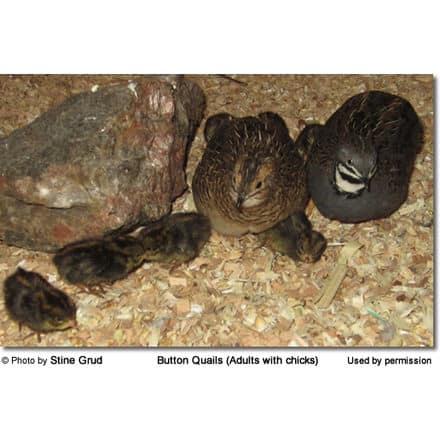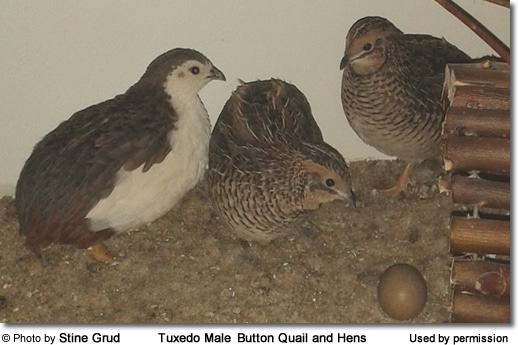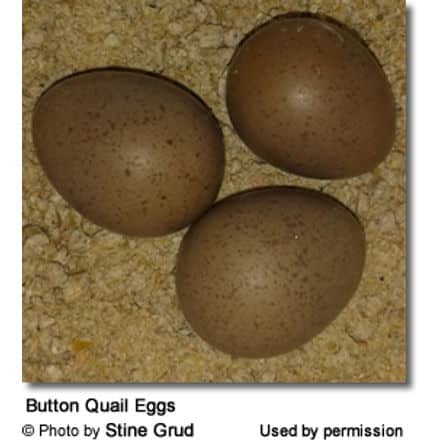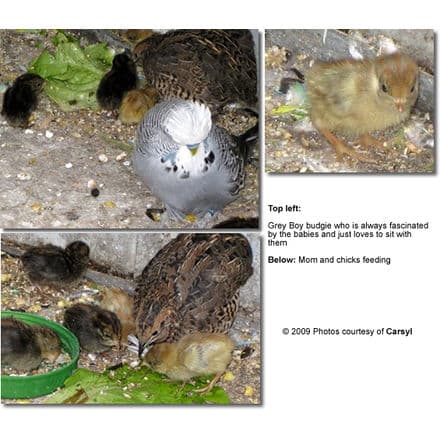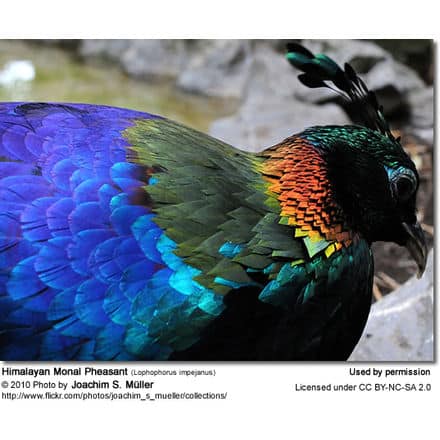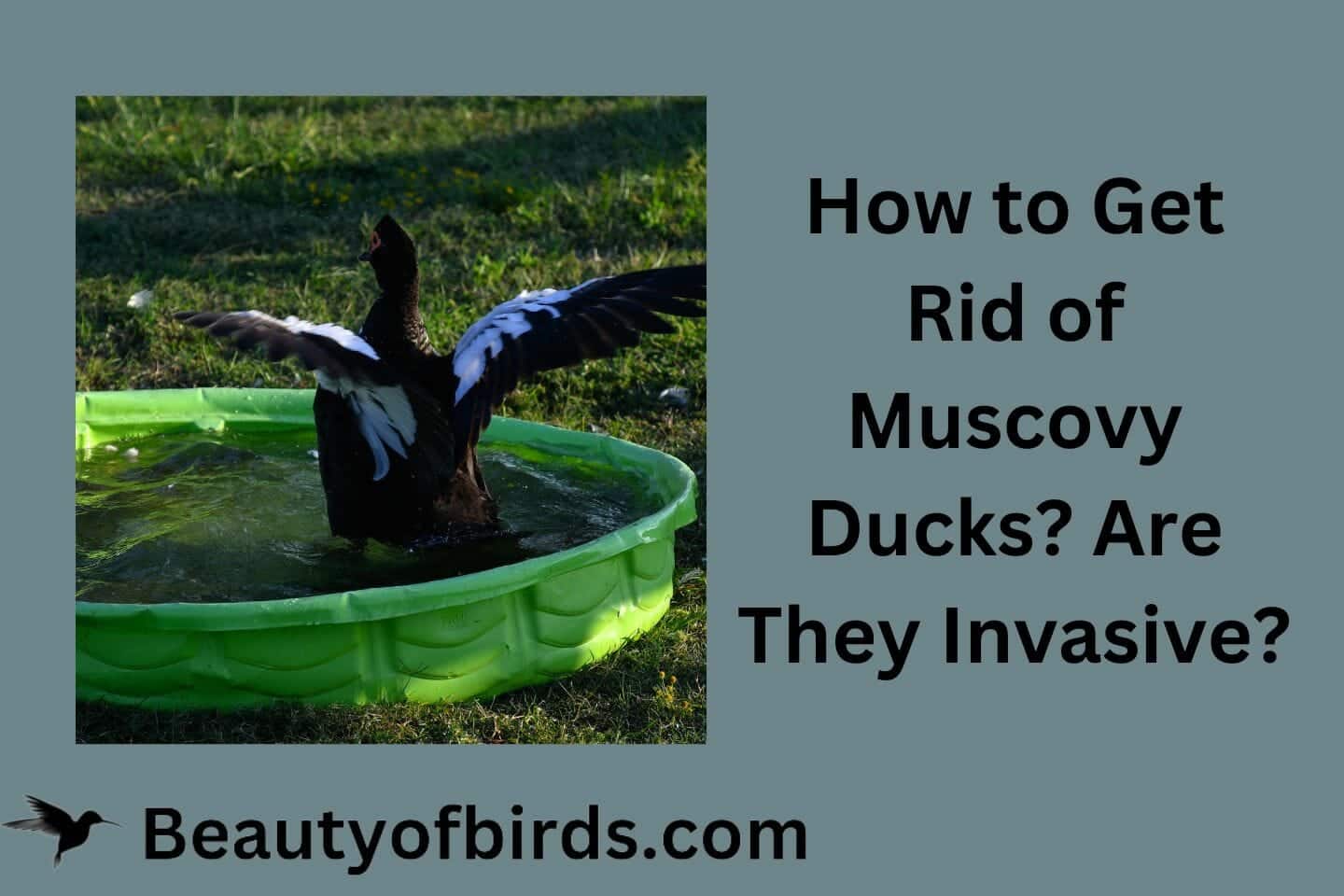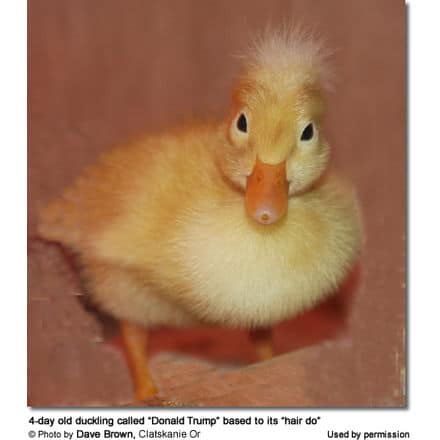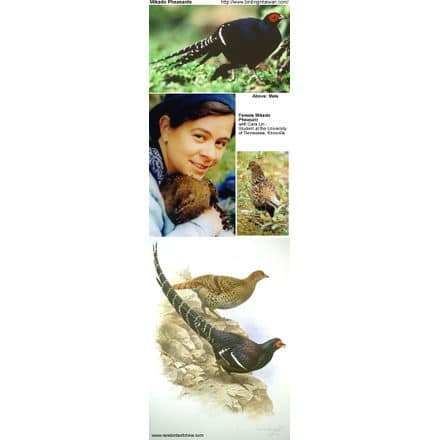Buttonquails or Hemipodes
The Buttonquails or Hemipodes (Turnicidae)
The Chinese Painted Quails – also known as buttonquails – (Coturnix chinensis, formerly Excalfactoria chinensis) resemble, but are unrelated to the true quails.
They naturally occur in the Old World, ranging from southeastern Asia to Oceania. They inhibit warm grasslands.
10 different subspecies have been identified.
Description
The Chinese Painted Quails come in several colors from blue to brown, silver, white, white and brown, grey, grey white brown blue, and more.
If well cared for, they can live up to 13 years; however, most only get 5 – 7 years old. They have orange feet.
These are small running birds avoid flying. They grow quickly — they are sexually mature in just six weeks after hatching!
Gender Identification
- Size: The hen is slightly larger and plumber than the male, averaging 5 inches in length, while the male is usually around 4.5 inches long.
- Color: Males are generally more colorful than the female.
- Bib: In standard colors, the male has a black and white bib that runs under the chin. This bib is one distinguishing factor when assessing the gender. However, this bib may not be present in mutation colors.
- Vent-spacing: Hens have wider and more flexible vent openings than males (she has to pass eggs after all). This method of sexing only works on adult hens and even then is not a 100% accurate sexing method (some hens are naturally “slender”) — This method works best when the hen is in breeding condition.
- Call: Males can also be distinguished by listening for their little calls that sound like: pee pee pew.
Keeping Button Quails as Pets or Aviary Birds
Button Quails can become very tame and may readily accept being scratched under the chin. They are not cuddly birds, but their antics are amusing and their size and quietness make them an easy-to-care-for pet.
I prefer to see them in an aviary environment. They add some visual variety to the aviary. Also, buttonquails clean up spilled seeds from the aviary floor. This is acceptable, but bird droppings need to be cleaned off the aviary floor, and the aviary should not overcrowded.
Their feet is not made for perching, but rather for walking. Therefore, the floor should not be wire. Natural soil is fine – however, it is harder to keep clean and may eventually carry a heavy load of parasites which may infect the quails or other birds. I actually like concrete, as you can hose it down daily, making clean-up a breeze. Adding some non-toxic potted plants will add interest to the aviary and will offer an enriched environment for the birds.
Breeders see the benefits of keeping these peaceful little quails in their parrot / bird aviaries, as they “clean up” all the seeds that the other birds drop to the floor. However, they should only be kept with non-aggressive birds / parrots, as they are easy prey for birds who may kill them for entertainment or may even feed on them. One breeder described how he kept button quails with his lories for many months until one day he found all the button quail dead with their heads missing.
It seemed that the lories had made a game out of biting their heads off. Another breeder lets lose small live little birds (parakeets, quails) into his parrot aviaries, which are quickly hunted down and killed by the parrots. This is something that I consider a reprehensible, cruel practice.
Quails are also kept in cages or aquariums – but I do not like that concept.
Food and water must be accessible to the quail on the floor of their home.
Button quails like to have placed to hide — an upside-down rectangular (shoebox-size) box with two doors cut in work great, a plastic plant container, upside down with a “door” cut in works great too (and last forever); and / or plants with hanging foliage work great (non-toxic please)!

Breeding
Breeding pairs require a minimum of four square feet of floor space. Being confined to a smaller space is likely going to result in aggressive behavior. The female needs a place to “get away” from her mate, so in addition to sufficient floor space, hiding places should be provided to make her feel secure.
A clutch consists of anywhere from 5 to 13 eggs. The hen usually starts incubating only after all the eggs have been laid. In captivity, if the female lays too many eggs, the oldest ones should be removed, as after about 10 days they go cold and die. Also, the more eggs a female lays, the slimmer the chances that all will hatch. A manageable number of eggs in a clutch would be 6 to 8. The baby quails hatch after about 19 days and look a lot like chicken chicks but smaller.
Incubating hens need to be provided with privacy and security. Breeders may place a small shelter on the floor of their pen. Alternativvely, a fabricated wooden shelter, a small hollow branch or low growing shrubs work fine as well.
Feeding your Buttonquails
Button Quails require animals for protein, vegetables and mineral and vitamin supplements to be healthy. Their primary need is a diet high in protein, and the staple of their diet should be “gamebird crumble” – which is over 20% protein. Live food should be offered, such as mealworms, crickets and fly larvae (maggots). These are commercially available at your local pet store, and are fairly inexpensive. Mealworms are high and fat and no more than 5 or 6 per day should be fed to your buttonquail. Protein can also be provided in the form of hard-boiled eggs, algae, spirulina and cooked beans.
Grit should be offered in a shallow bowl – big enough for them to sit in. In addition to providing minerals, grit will help their digestion and is an important part in quail hygiene. They will “bathe” in the grit.
A good vitamin supplement is also very important. Better bird / pet stores have some choices for you available. Stick with the “powders” rather than the liquid vitamins, which are mixed in with water. They will cause water to “go off” and you are never sure how much of the supplement they are actually getting. Some birds may actually go off the water as they may not like the taste, which could cause them to dehydrate. Powder mixed with their favorite foods (coating mealworms, for example with it) works best.
Click To Buy:
UnRuffledRx Nutritional Calcium Supplement for Birds Magnesium + Vitamin D3
Hatortempt 10lbs Bulk Dried Mealworms – Premium Non-GMO Organic
HealthyGut™ Avian Probiotics Dietary Supplement for Parrots
Special Care for Female Button Quails
The production of eggs uses vast amounts of the female’s resources, which must be compensated for in diet and lighting. Button quail can lay an egg every day. This practice can quickly depelete her calcium and other nutrients resulting in disease and even death. A calcium supplement is essential. Offering crushed oyster shells and/or smashed eggshell of boiled eggs mixed in with the grit will help maintain her optimum calcium levels. Alternatively, you could use cuttlebone available in the bird section of pet stores, “Pet-Cal” – which is a supplement for dogs and cats; or any regular human calcium supplement would be acceptable as well. Natural sunlight is important for Vitamin D production.
Nesting Females
The hen is likely to sit on the eggs almost non-stop, leaving them only to eat and relieve herself. She is protective of her clutch. If they are not fertilized, I would allow her to keep the eggs for about 20 days. If you remove the eggs prior to that, she will continue to lay eggs potentially causing harm to her health. Save any undamaged eggs in a basket / container (not airtight!) – mark each egg to be able to differentiate them from new eggs in the future. As the female gets started on a new clutch – after the first egg has been laid – simply add the old eggs, to discourage her from laying more eggs.
Of course, if the eggs are fertilized and you want her to raise chicks, she will proceed as is natural and will do so without too much assistance from you. Please note that during this time her nutritional requirements need to be paid attention to more so than at any other time. She will need more protein and minerals than in non-breeding times.

